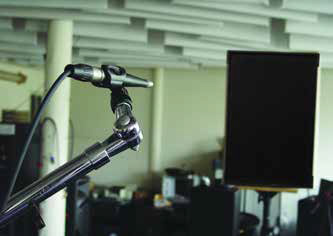
One more thing to know about how loudspeaker levels are tested: as you move farther away from any point source making noise in open space, the sound level drops off at a theoretically predictable rate, with each doubling of distance causing a 6 dB (1/2) drop.
If we use an SPL meter to measure a loudspeaker at 100 dB SPL from 1 meter away, then it will read 94 dB at 2 meters, 88 dB at 4 meters, 82 dB at 8 meters, 76 dB at 16 meters, and 70 dB at 32 meters. (This is the theoretical “free field” case, similar to being outdoors without any wall reflections.)
Weighty Matters
As noted, the standard distance for loudspeaker max SPL measurements is 1 meter (just over 3 feet). Because just 1 meter of distance can be a little too close to allow the combined patterns from the various drivers to come together as a point source, in many cases the manufacturers will do the test at 2 meters away, then add 6 dB for the number published in their literature.
Thus if you see someone in a video measuring the sound level of a loudspeaker with the SPL meter jammed into the mouth of the horn, then they have no idea what they’re talking about. Sorry, but the internet is full of misinformed “experts” who can’t do dB math.
There’s one more setting to consider – the A-weighted versus C-weighted scale on an SPL meter. These weighting scales filter the frequency response of the measured data to more closely match the frequency response of the human ear at different levels. These weighing curves are basically frequency filters placed between the microphone and the internal voltage detector in the SPL meter.
The unweighted option is also called “Z weighting” and is used to accurately assess the actual SPL in the room to the highest and lowest extremes of the audible range. However, this may not correlate well with how well we perceive the same environment, due to our ears’ lower sensitivity at the ends of the spectrum.
For example, the “A-curve” ignores most of these very low frequencies as well as many of the normal bass notes (Figure 2). This give a more accurate SPL number as to how loud something actually “sounds” in a mix to our ears at a moderate volume, while the C weighting curve is a match for human perception at concert levels.

So if you see something like 98 dBA, what they really mean is 98 decibels of sound pressure level using the A-weighted scale, which is a standardized way to measure apparent sound levels according to many noise standards and legislation. The C-weighted scale will often read 10 dB (or more) louder for the same sound source compared to the A-scale because of the higher sensitivity to low frequencies.
This idea of a 6 dB drop with each doubling of distance from the loudspeaker provides an explanation of why an SPL meter may be reading a sultry 90 dBA SPL at the mixing console in the back of the room while listeners in the front row could be getting hit with 110 dBA SPL. This natural sound level difference from the front to the back of the listening rooms occurs with all loudspeakers. Or does it?
